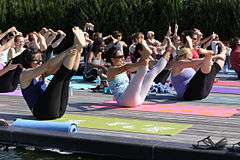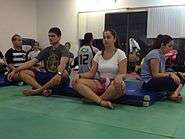Yoga as exercise

Yoga as exercise is a modern phenomenon which has been influenced by the ancient Indian practice of hatha yoga. It involves holding stretches as a kind of low-impact physical exercise, and is often used for therapeutic purposes.[1] Yoga in this sense often occurs in a class and may involve meditation, imagery, breath work and music.[2][3]
Both the meditative and the exercise components of hatha yoga have been researched for both specific and non-specific fitness and health benefits. Hatha yoga has been studied as an intervention for many conditions, including back pain, stress, and depression.[4]
A survey released in December 2008 by the US National Center for Complementary and Integrative Health found that hatha yoga was the sixth most common integrative health approach amongst adults in the United States during 2007, with an estimated six percent of the population participating.[5][6]
Background and overview
Yoga has roots in India. The foundational text for yoga is the Yoga Sutras of Patanjali. Yoga came to the attention of an educated western public in the mid 19th century along with other topics of Hindu philosophy. The first Hindu teacher to actively advocate and disseminate aspects of yoga to a western audience was Swami Vivekananda, who toured Europe and the United States in the 1890s[7] (however, Vivekananda put little emphasis on the physical practices of Hatha Yoga in his teachings).[8]

Nearly all types of hatha yoga practices include asana, pranayama and savasana.[9] The physical asanas of hatha yoga have a tradition that goes back to at least the 15th century, but they were not widely practiced in India prior to the early 20th century. Hatha yoga was advocated by a number of late 19th to early 20th century gurus in India, including Tirumalai Krishnamacharya in south India, Swami Sivananda in the north, Sri Yogendra in Bombay, and Swami Kuvalayananda in Lonavala, near Bombay.[10] In 1918, Pierre Bernard, the first famous American yogi, opened the Clarkstown Country Club, a retreat center for well-to-do yoga students, in New York State.[11] In the 1960s, several yoga teachers, most notably B.K.S. Iyengar, K. Pattabhi Jois, Swami Vishnu-devananda, and Swami Satchidananda became active and popular in the West.[10][12][13]
A hatha "yoga boom" followed in the 1980s, as Dean Ornish, MD, a medical researcher and follower of Swami Satchidananda, connected hatha yoga to heart health, legitimizing hatha yoga as a purely physical system of health exercises outside of counter culture or esotericism circles, and unconnected to a religious denomination.[7] Since then, hatha yoga has been used as supplementary therapy for diverse conditions such as cancer, diabetes, and asthma.[14]
The more classical approaches of hatha yoga, such as Iyengar Yoga, move at a more deliberate pace, emphasize proper alignment and execution and hold asanas for a longer time. They aim to gradually improve flexibility, balance, and strength. Other approaches, such as Ashtanga or Power Yoga, shift between asanas quickly and energetically. More recently, contemporary approaches to yoga, developed by Vanda Scaravelli and others, invite students to become their own authority in yoga practice by offering principle-based approaches to yoga that can be applied to any form.[15]
Research activity
Much of the research on Hatha Yoga has been in the form of preliminary studies or clinical trials of low methodological quality, including small sample sizes, inadequate blinding, lack of randomization, and high risk of bias.[16][17] As of 2011, evidence suggests that Hatha Yoga may be effective at improving health outcomes as a form of mild physical exercise when added to standard care. Hatha Yoga does not have specific and standardization regarding its practice. A study suggested for creation of supported practices that could be distributed and applied for use in clinical practice for patients.[18]
Mental health conditions
Yoga is a core component of the Mindfulness-based stress reduction (MBSR) program. Drawing from recent research on the mental and physical benefits of practicing yoga, positive psychologists have begun to look deeper into the possibilities of utilizing yoga to improve life for people even in the absence of disease.[18]

The therapeutic benefits of yoga have been discussed by van der Kolk, who explains that because regulation of physical movement is a fundamental priority of the nervous system, focusing on and developing an awareness of physical movement can lead to improved synchrony between mind and body. This is beneficial, he says, especially for those suffering from psychological conditions such as depression and PTSD (the focus of van der Kolk’s work), because an improved sense of connectedness between mind and body give rise to enhanced control and understanding of their "inner sensations" and state of being.[18]
A 2010 literature review of the research on the use of Hatha Yoga for treating depression said that preliminary research suggests that Hatha Yoga may be effective in the management of depression. Both the exercise and the mindfulness meditation components may be helpful. However the review cautioned that "Although results from these trials are encouraging, they should be viewed as very preliminary because the trials, as a group, suffered from substantial methodological limitations."[19]
A 2015 systematic review on the effect of yoga on mood and the brain concluded that "yoga is associated with biological changes in blood pressure, heart rate, cortisol or cytokine levels. It is therefore plausible that yoga may affect mood via SNS and HPA axis regulation."[20] The same review also points to a lack of research in this field and recommends more methodological rigor be applied to future RCTs to solidify these conclusions.
There is some evidence that exercise programs may help people with dementia perform their daily activities.[21] There has been no found benefit to treating attention deficit hyperactivity disorder.[16] There is some evidence supporting yoga as an alternative treatment for insomnia, however it is not of good quality and it is not clear whether yoga works any better than general relaxation.[22]
Physical health conditions
There is evidence that Hatha Yoga may be effective in the management of chronic, but not acute, low back pain.[23] Only weak evidence exists to support the use of Hatha Yoga as a complementary therapy for helping people with rheumatic diseases, and little is known of the safety of such use.[24]
Although some evidence exists to suggest Hatha Yoga might help people with high blood pressure, overall this evidence is too weak for any recommendation to be made, and little is known of the safety implications of such an approach.[25] There is no evidence of benefit in treatment of epilepsy or menopause-related symptoms.[26][27] Practice of Hatha Yoga may improve quality-of-life measures in cancer patients.[28] Hatha Yoga has no effect on the underlying disease.[4]
Safety

Although relatively safe, Hatha Yoga is not risk free. Sensible precautions can usefully be taken – for example beginners should avoid advanced moves, Hatha Yoga should not be combined with psychoactive drug use, and competitive Hatha Yoga should be avoided.[29] A small percentage of Hatha Yoga practitioners each year suffer physical injuries analogous to sports injuries.[30]
When using Hatha Yoga as a treatment, patients should inform the teacher of their physical limitations and concerns. Functional limitations should be taken into consideration. Modifications can then be made using props, altering the duration or poses.[31] The practice of Hatha Yoga has been cited as a cause of hyperextension or rotation of the neck, which may be a precipitating factor in cervical artery dissection.[32]
See also
- Yoga foot drop
- International Journal of Yoga
- Exercise is Medicine
- Neurobiological effects of physical exercise
References
- ↑ Syman, Stefanie (2010). The Subtle Body: The Story of Yoga in America. Macmillan. pp. 268–273.
- ↑ Feuerstein, Georg (2006). ""Yogic Meditation"". In Jonathan Shear. The Experience of Meditation. St. Paul, Minnesota: Paragon House. p. 90.
While not every branch or school of yoga includes meditation in its technical repertoire, most do.
- ↑ Editors, of Yoga Journal (2010). "Which Yoga is Right for you?". Yoga Journal: 80–85.
- 1 2 "Yoga". American Cancer Society. 1 November 2008. Retrieved April 2014. Check date values in:
|access-date=(help) - ↑ Barnes, P. M.; Bloom, B.; Nahin, R. CDC National Health Statistics Report #12. Complementary and Alternative Medicine Use Among Adults and Children: United States, 2007
- ↑ "According to a New Government Survey, 38 Percent of Adults and 12 Percent of Children Use Complementary and Alternative Medicine | NCCIH". Nccih.nih.gov. 2008-12-10. Retrieved 2012-03-20.
- 1 2 Shaw, Eric. 35 mOMents, Yoga Journal, 2010-09.
- ↑ Goldberg, Philip (2010). American Veda—How Indian Spirituality Changed the West. New York: Crown/Random House. p. 79. ISBN 978-0-385-52134-5.
- ↑ Forbes Bo. "Yoga Therapy in Practice: Using Integrative Yoga Therapeutics in the Treatment of Comorbid Anxiety and Depression". International Journal of Yoga. 2008: 87.
- 1 2 Cushman, Ann (Jan–Feb 2000). "The New Yoga". Yoga Journal.com. p. 68. Retrieved 5 May 2011.
- ↑ Love, Robert (2010). The Great Oom : the Improbable Birth of Yoga in America. Viking. ISBN 067002175X.
- ↑ Silva, Mira, and Mehta, Shyam. (1995). Yoga the Iyengar Way, p. 9. Alfred A. Knopf, New York. ISBN 978-0-89381-731-2
- ↑ Desikachar, T. K. V. (2005). Health, healing and beyond: Yoga and the living tradition of Krishnamacharya, (cover jacket text). Aperture, US. ISBN 978-0-89381-731-2
- ↑ Barnes, P.; Powell-Griner, E.; McFann, K.; Nahin, R. CDC Advance Data Report #343. Complementary and Alternative Medicine Use Among Adults: United States, 2002
- ↑ Marc Woolford About the Yoga.... yoga is meant for anyone that wishes to improve physical and psychological health
- 1 2 Krisanaprakornkit, T.; Ngamjarus, C.; Witoonchart, C.; Piyavhatkul, N. (2010). "Meditation therapies for attention-deficit/hyperactivity disorder (ADHD)". Cochrane Database of Systematic Reviews (6): CD006507. PMID 20556767. doi:10.1002/14651858.CD006507.pub2.
- ↑ Uebelacker, L. A.; Epstein-Lubow, G.; Gaudiano, B. A.; Tremont, G.; Battle, C. L.; Miller, I. W. (2010). "Hatha yoga for depression: critical review of the evidence for efficacy, plausible mechanisms of action, and directions for future research". Journal of Psychiatric Practice. 16 (1): 22–33. PMID 20098228. doi:10.1097/01.pra.0000367775.88388.96.
- 1 2 3 Salmon, Paul; Lush, Elizabeth; Jablonski, Megan; Sephton, Sandra E. (February 2009). "Yoga and Mindfulness: Clinical Aspects of an Ancient Mind/Body". Cognitive and Behavioral Practice. 16 (1): 59–72. doi:10.1016/j.cbpra.2008.07.002.
- ↑ Uebelacker LA, Epstein-Lubow G, Gaudiano BA, Tremont G, Battle CL, Miller IW (January 2010). "Hatha yoga for depression: critical review of the evidence for efficacy, plausible mechanisms of action, and directions for future research". J Psychiatr Pract. 16 (1): 22–33. PMID 20098228. doi:10.1097/01.pra.0000367775.88388.96.
- ↑ Pascoe, Michaela C.; Bauer, Isabelle E. (2015-09-01). "A systematic review of randomised control trials on the effects of yoga on stress measures and mood". Journal of Psychiatric Research. 68: 270–282. ISSN 1879-1379. PMID 26228429. doi:10.1016/j.jpsychires.2015.07.013.
- ↑ Forbes, Dorothy; Forbes, Scott C.; Blake, Catherine M.; Thiessen, Emily J.; Forbes, Sean (2015-04-15). "Exercise programs for people with dementia". The Cochrane Database of Systematic Reviews (4): CD006489. ISSN 1469-493X. PMID 25874613. doi:10.1002/14651858.CD006489.pub4.
- ↑ Taylor DJ, Grieser EA, Tatum JI (2010). "Other Nonpharmacological Treatments of Insomnia". In Sateia MJ, Buysse D. Insomnia: Diagnosis and Treatment. CRC Press. p. 291. ISBN 9781420080803.
- ↑ Chou R, Huffman LH (October 2007). "Nonpharmacologic therapies for acute and chronic low back pain: a review of the evidence for an American Pain Society/American College of Physicians clinical practice guideline". Ann. Intern. Med. 147 (7): 492–504. PMID 17909210. doi:10.7326/0003-4819-147-7-200710020-00007.
- ↑ Cramer H, Lauche R, Langhorst J, Dobos G (November 2013). "Yoga for rheumatic diseases: a systematic review". Rheumatology (Oxford). 52 (11): 2025–30. PMID 23934220. doi:10.1093/rheumatology/ket264.
- ↑ Wang J, Xiong X, Liu W (2013). "Yoga for essential hypertension: a systematic review". PLoS ONE. 8 (10): e76357. PMC 3790704
 . PMID 24124549. doi:10.1371/journal.pone.0076357.
. PMID 24124549. doi:10.1371/journal.pone.0076357. - ↑ Panebianco, Mariangela; Sridharan, Kalpana; Ramaratnam, Sridharan (2015-05-02). "Yoga for epilepsy". The Cochrane Database of Systematic Reviews (5): CD001524. ISSN 1469-493X. PMID 25934967. doi:10.1002/14651858.CD001524.pub2.
- ↑ Lee, M. S.; Kim, J. I.; Ha, J. Y.; Boddy, K.; Ernst, E. (2009). "Yoga for menopausal symptoms: a systematic review". Menopause (New York, N.Y.). 16 (3): 602–608. PMID 19169169. doi:10.1097/gme.0b013e31818ffe39.
- ↑ Smith, K. B.; Pukall, C. F. (May 2009). "An evidence-based review of yoga as a complementary intervention for patients with cancer". Psycho-oncology. 18 (5): 465–475. PMID 18821529. doi:10.1002/pon.1411.
- ↑ Cramer H, Krucoff C, Dobos G (2013). "Adverse events associated with yoga: a systematic review of published case reports and case series". PLoS ONE. 8 (10): e75515. PMC 3797727
 . PMID 24146758. doi:10.1371/journal.pone.0075515.
. PMID 24146758. doi:10.1371/journal.pone.0075515. - ↑ Penman S, Cohen M, Stevens P, Jackson S (July 2012). "Yoga in Australia: Results of a national survey". Int J Yoga. 5 (2): 92–101. PMC 3410203
 . PMID 22869991. doi:10.4103/0973-6131.98217.
. PMID 22869991. doi:10.4103/0973-6131.98217. - ↑ Distasio S (2008). "Integrating Yoga into Cancer Care". Clinical Journal of Oncology Nursing. 12 (1): 125–130. PMID 18258582. doi:10.1188/08.CJON.125-130.
- ↑ Caso V, Paciaroni M, Bogousslavsky J (2005). "Environmental factors and cervical artery dissection". Front Neurol Neurosci. 20: 44–53. PMID 17290110. doi:10.1159/000088134.